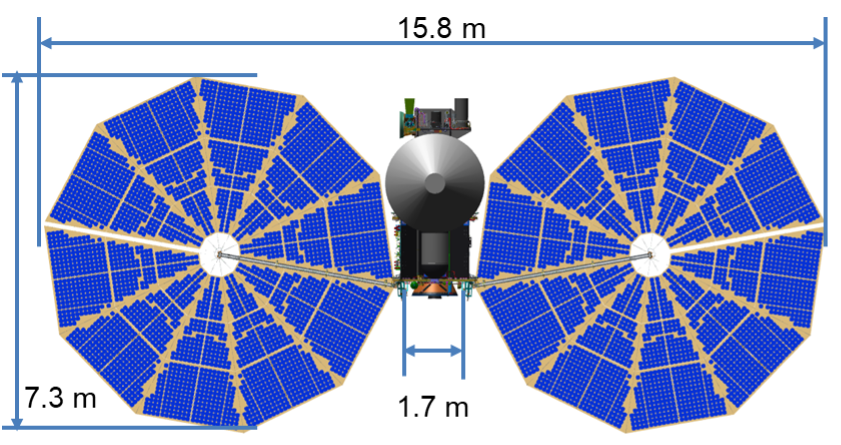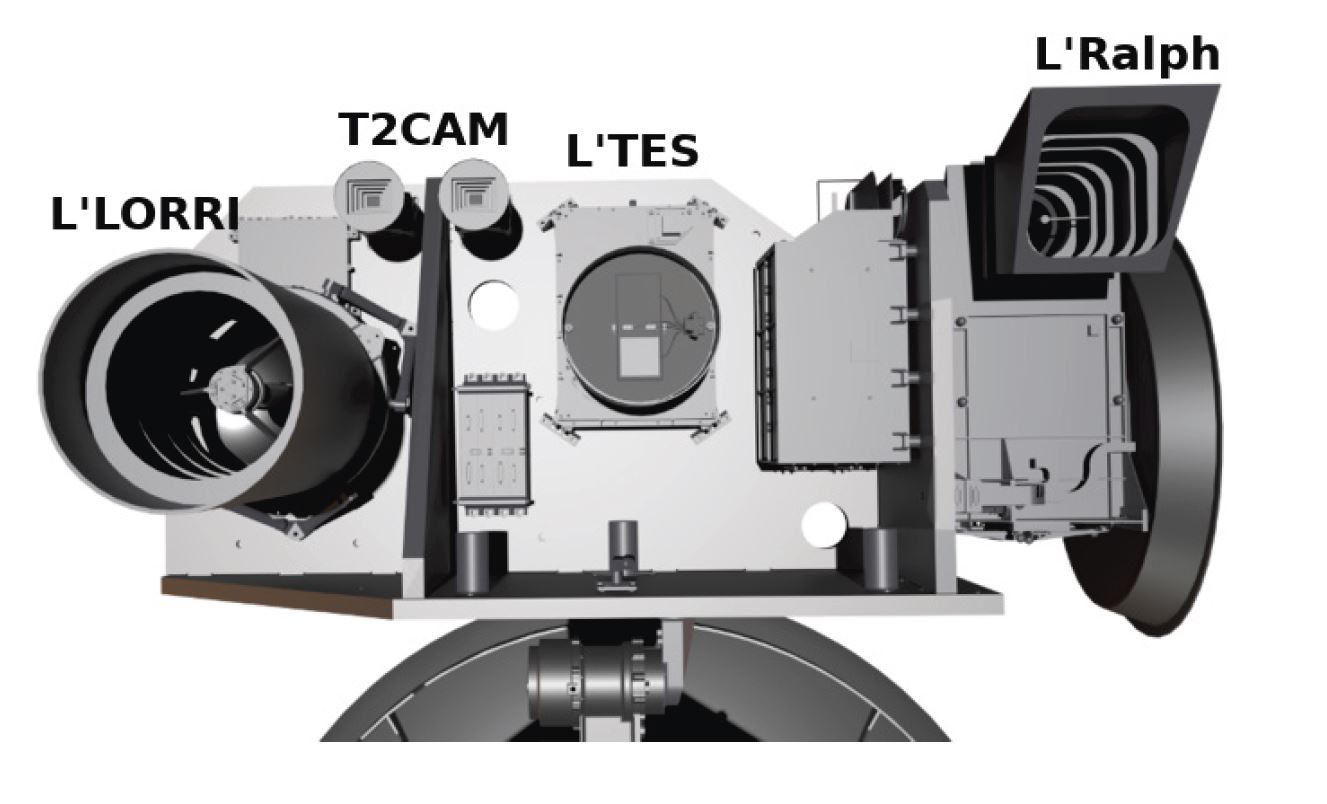The Lucy Spacecraft
Lucy is more than 52 feet (16 meters) from tip to tip, but most of that is the huge solar panels (each close to 24 feet, or over 7 meters, in diameter) needed to power the spacecraft’s systems as it flies out to the orbit of Jupiter. All the instruments, and the 6.5 ft (2 meters) high gain antenna needed to communicate with Earth, will be located on the much smaller spacecraft body.
- Width: 51.89ft (15.82m)
- Height: 23.89 ft (7.28m) when solar arrays deployed or
12.95ft (3.95m) when Solar panels are stowed - Depth: 6.57 ft (2.00m)
- Diameter of Solar Panels: 23.9 ft (7.3m)
- Dry Mass (Unfueled): 1,700 lbs. (771kg)
- Wet Mass (Fueled): 3,300 lbs. (1500 kg)
- Power: 504 Watts at the farthest encounter
Science Instruments
Lucy will explore the Trojan asteroids with a suite of remote sensing instruments:
L’LORRI
The Lucy LOng Range Reconnaissance Imager L’LORRI, is Lucy’s most sensitive and highest resolution camera. This panchromatic (black-and-white) camera is a type of Ritchey–Chrétien telescope, the same basic design as the Hubble Space Telescope. Light travels down the tube and is reflected by the hyperbolic primary mirror, then travels back up the tube and is reflected by the hyperbolic secondary mirror.
The secondary mirror focuses the light through an opening in the primary mirror. It then passes through a set of lenses. The image is recorded with a charge-coupled device, the light sensitive device used in some digital cameras.
One of L’LORRI’s objectives is to produce clear images of the Trojan asteroids, despite their being extremely dark. From 621 miles (1,000 km) away, L’LORRI will be able to clearly see craters with a diameter of 229 feet (70 meters) (i.e., 45 feet or 14 meters per resolution element), which is like standing at one end of a football field and being able to see a fly at the other end.
L’LORRI’s detailed images will help Lucy’s science team understand the surface geology of the Trojan asteroids,
including their craters, which record impacts by other asteroids over time. L’LORRI will also search for rings and
satellites, as well as help with optical navigation.
L’LORRI is panchromatic (detecting the entire visible spectrum) and does not use optical filters. L’LORRI has no
moving parts, not even a focusing mechanism, which reduces risk. Most of L’LORRI’s optical system is made of silicon carbide.
L’LORRI was built by Johns Hopkins Applied Physics Laboratory, under the leadership of Harold Weaver (Instrument Principal Investigator) and Neil Dello Russo (Instrument Deputy Principal Investigator). The instrument is based on New Horizons’ LORRI instrument, which collected most of the incredibly detailed images of Pluto (2015) and the Kuiper Belt object Arrokoth (2019). Though a few changes were made to New Horizons’ LORRI for the Lucy mission (such as replacing its composite baffle with stronger aluminum, adding a second
electronic pathway and more memory), L’LORRI retains much of its predecessor’s tried-and-tested design.
L’Ralph
L’Ralph will search the Trojan asteroids’ surfaces for organic compounds, ices, and hydrated minerals, and its images will help us determine the Trojans’ surface compositions. L’ Ralph is actually two instruments in one — MVIC (Multispectral Visible Imaging Camera), a color visible imager, and LEISA (Linear Etalon Imaging Spectral Array), an infrared spectrometer. A beamsplitter inside sends the infrared light to LEISA and reflects the visible light to MVIC.
MVIC has five color bands that cover the visible to near infrared spectrum. The bands are chosen to help scientists identify compositional elements on the surfaces of the Trojan asteroids. For example, the phyllosilicate band is sensitive to phyllosilicates, a kind of hydrated mineral scientists expect to find on the Trojans’ surfaces while the other bands are sensitive to a range of materials. In addition, the slope of the reflected light measured in all the bands helps identify the color of the surface and gives clues to its history. There is also a panchromatic band that covers the entire visible/near IR range that allows very sensitive comparisons to be made between the properties of different areas of the surface MVIC uses six CCDs arrays (the light-sensitive devices used
in digital cameras in place of film), each with up to 64 rows of 5,000 pixels each to take its images.
LEISA contains a linear etalon, a thin, slightly sloped, transmitting layer of sapphire surrounded by a pair of reflective surfaces, slightly sloped on one sided, that separates light into a spectrum, like a prism.
LEISA images can be analyzed based on how different substances on the asteroid’s surface behave when absorbing different wavelengths of light, allowing the identification of the different kinds of rocks, ices, and organic compounds that could be present. From 1000 km (621 miles) away, LEISA will be able to resolve craters on the order of 1, 540 feet (500 meters) wide.
Like L’LORRI, L’Ralph does not have a focusing mechanism. To avoid defocusing or other problems caused by temperature changes, most of L’Ralph is made from a single block of aluminum. Even the mirrors are made of aluminum, and diamonds were used to turn the metal into finely polished surfaces. And because the images L’Ralph will take are so large, it also has 256 gigabits of onboard memory.
NASA’s Goddard Space Flight Center built L’Ralph, under the leadership of Dennis Reuter (Instrument Principal Investigator) and Amy Simon (Instrument Deputy Principal Investigator).
L’Ralph is based on the New Horizons instrument Ralph, as well as OSIRIS-REx’s OVIRS. Ralph gathered New Horizons’ incredible color images of Pluto, Charon (2015), and Arrokoth (2019). Lucy’s new iteration of Ralph has several improvements from its New Horizons predecessor, such as a much broader IR spectral range, the addition of onboard memory, and a scanning mirror that allows images to be taken without additional spacecraft motion. Despite this, L’Ralph still runs on much less power than the average ceiling fan (less than 30
Watts).
L’TES
Though the Trojan asteroids are many hundreds of millions of kilometers from the Sun, sunlight still heats them up, and the warm surfaces naturally emit far infrared radiation. The Lucy Thermal Emission Spectrometer (L’TES) detects this radiation, using a telescope with diameter 15.2 cm (5.98 in) to focus the incoming energy onto a small detector. In this way, L’TES acts like a remote thermometer. L’TES is not an imager, but it can take temperature measurements at various points on an asteroid, which can be combined to produce a “picture” of the physical surface properties. While Lucy’s other spectrometer (LEISA on L’Ralph) will probe the asteroids’ surface
composition, the temperature measurements from L’TES will help the science team deduce how quickly the surface heats up in sunlight and releases heat in shadow. Smaller surface particles, like sand on a beach, heat up and cool down quickly; larger particles, like a slab of concrete, do it more slowly. By measuring the temperature at different times of day, the team can deduce how much dust, sand, or rock is present in the regolith. L’TES could also detect any variation in thermal physical surface properties on a single asteroid, something an
earthbound telescope would not be able to detect.
L’TES was built by Arizona State University, under the leadership of Phillip Christensen (Instrument Principal
Investigator) and Victoria Hamilton (Instrument Deputy Principal Investigator). The instrument is based on OSIRIS REx’s OTES (OSIRIS-REx Thermal Emission Spectrometer). L’TES retained most of the hardware design, including its large diamond beamsplitter, from its predecessor, with electronics adapted from EMIRS (Emirates Mars Infrared Spectrometer), an instrument on the Emirates Mars Mission.
Mass determination via the Radio Science Experiment
In addition to these instruments, Lucy has a 6.5-ft-wide (2-meter) high gain antenna which will serve as the primary communications relay between the spacecraft and Earth.
Designed and built by Lockheed Martin, this same style antenna has been used to return science data from Mars
and transfer back photos of asteroid Bennu. With Lucy, the antenna will not only send back the first ever close-up images of the Trojan asteroids, but the team will also be able to use small velocity-induced shifts in the received radio frequency (the Doppler effect) to determine the masses of these never-before-visited space objects.
T2CAM
Lucy will use its terminal tracking camera (T2CAM) to help navigate the spacecraft and track the asteroids during
encounters. In addition to keeping the asteroids in the field of view of the main instruments, T2CAM will take wide-field images of the asteroids to better ascertain their shapes. The shape, along with the radio measurement of mass, will allow the science team to determine the density of material inside.






























